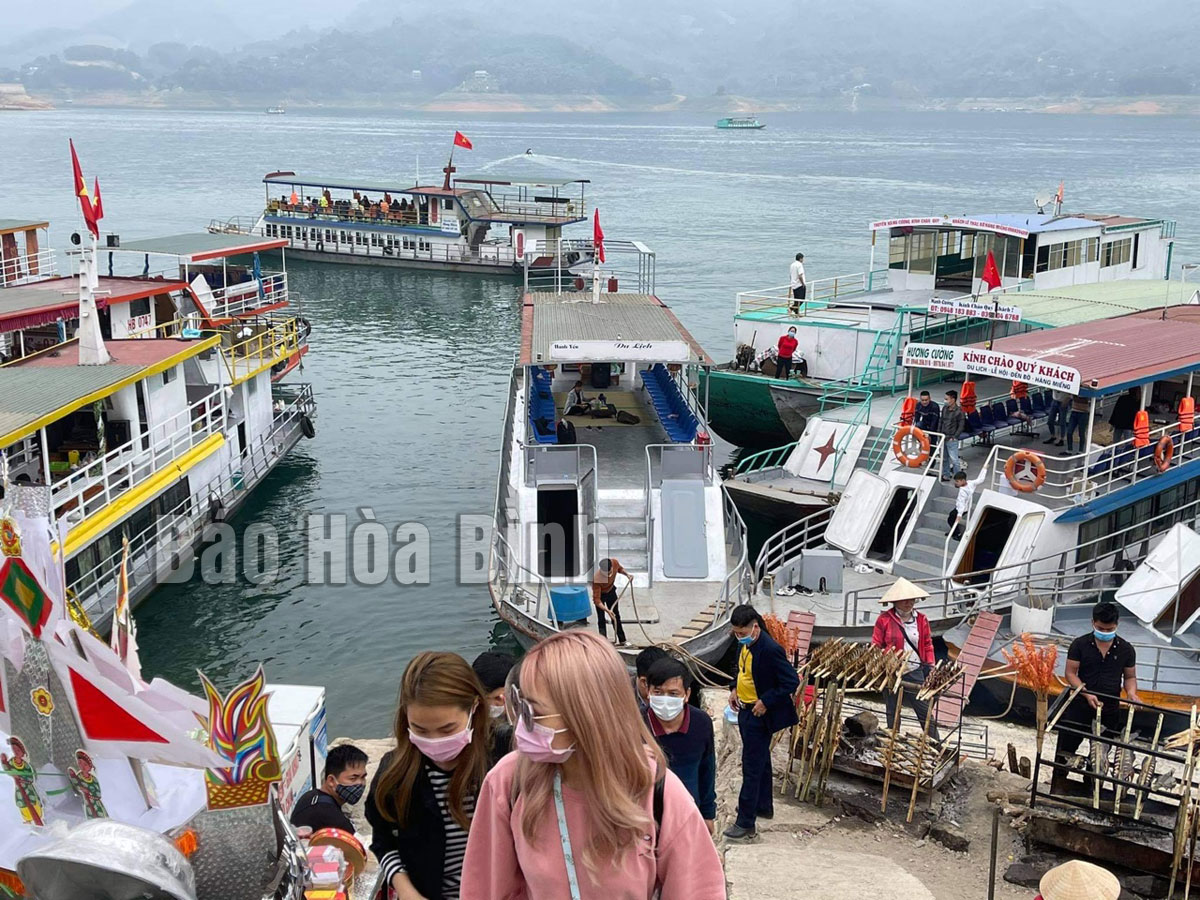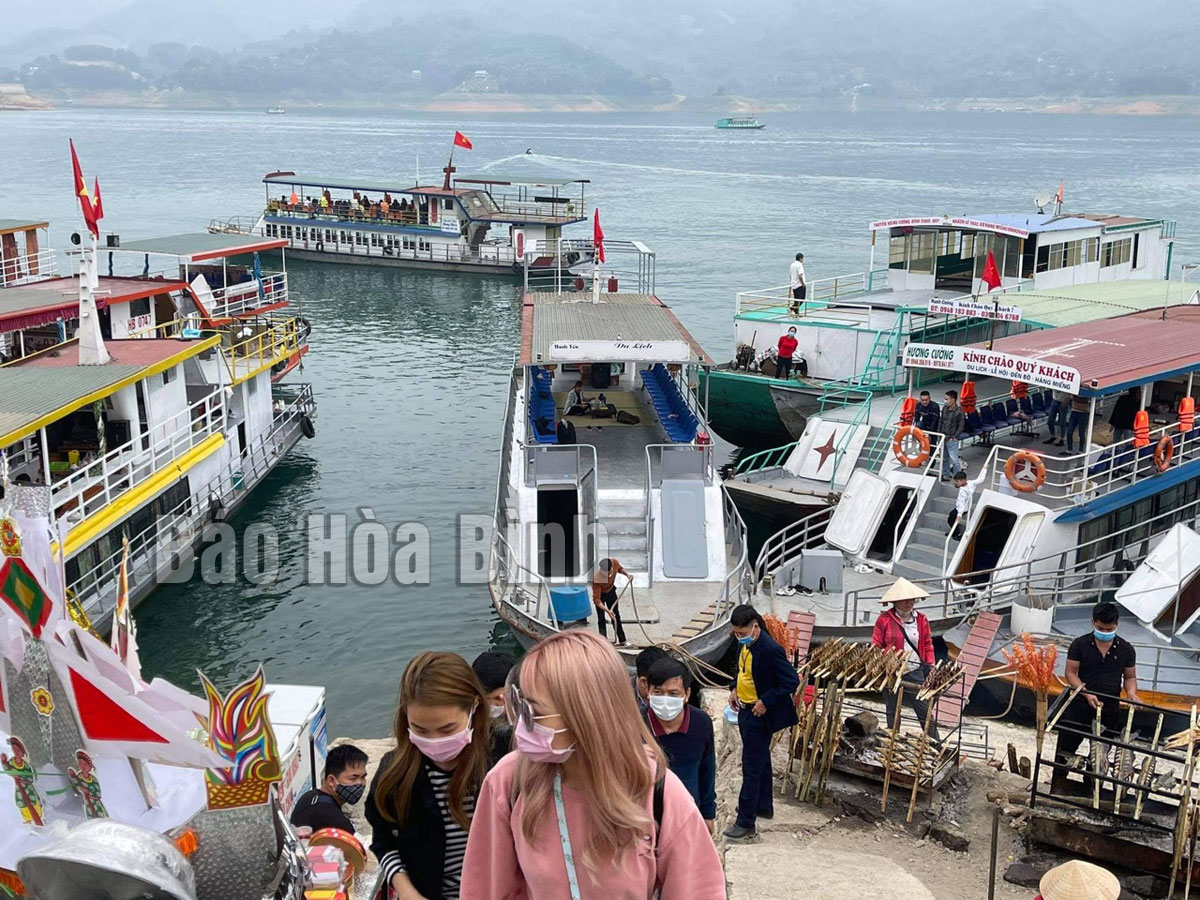



The tourists are going on the pilgrimage and doing sightseeing at the spiritual tourism destination of Thac Bo temple.
According to the legend, Ba Chua Thac Bo temple worships two female generals, Mrs. Dinh Thi Van, the Muong ethnic person, and another woman (the name is unknown) the Dao ethnic person. Under the reign of Le Loi King, the two women helped the people and army transport food and boats across Thac Bo to Muong Le (Son La) to quell the rebellion. After their death, the two women often appeared to help the people safely cross the famous dangerous and harsh waterfall when Da River had not stopped its flow. The people were grateful, so they built a temple to worship the two women, paying their respects and hoping that the two women will help and protect them from danger when they cross the river.
Being built in the view looking at the river, leaning on the mountain with the charming scenery, Thac Bo temple relics is divided into 2 areas. Ba Chua Thac Bo temple on the left bank is located on top of Hang Than hill in Vay Nua commune and Thac Bo temple on the right is located at the foot of Thac Bo, right next to Da River. Experiencing a number of times of restoration and reconstruction, the temple still retains its unique and characteristic features. The temple on the left has a nail-shaped floor plan, including the Dai Bai house and Hau Cung. In front of the temple, there are 5 doors covered with fish-scale tile roofs. A big picture written in Chinese characters is hung on the main door. There is a embossed dragon face on the roof. The temple on the right consists of 3 main altars and Hau Cung, there are 2 floors leaning against the mountain. The first floor is a place for the tourrists to stay, the second floor is a place worshiping the gods. In the temple, they worship not only Ba Chua Thac Bo but they also worship other gods such as the Great Council (Cong Dong Quan Lon), the five veneration of grandfathers, the princess Son Trang, the four palaces of Thanh Co, the four palaces of Thanh Cau, the Great King Tran Quoc Tuan, The four palaces of Chau Ba…
Located in the tourism chain with Da river lake bed and Thac Bo cave, Ba Chua Thac Bo temple is among the top famous tourism attractions of the province. Every year, the temple not only welcomes the pilgrims to ask for her blessings, but it also welcomes many tourists visiting and admiring the scenery and enjoying the fresh air. The temple’s festival takes place from the 7th of the first lunar month and it lasts until the end of the third lunar month. However, since the days in December of the previous year, there are a lot of visitors coming there to worship. To get to the temple, worshipers or tourists have to go through 2 stages, after the road is the river route with 3 main routes: from Thung Nai tourism port in Thung Nai commune (Cao Phong), which is the closest port to the temple with the travel time of about 15 minutes by motor boat; from Bich Ha port in Hoa Binh commune (Hoa Binh city) to the temple with a time of about 1 and a half hours; It takes about 45 minutes from Binh Thanh commune (Cao Phong) to the temple.
To schedule a pilgrimage trip in spring, doing sightseeing at Ba Chua Thac Bo temple, visitors can refer to some useful information: If go worshiping, stop at Trinh temple first to present their names in front of the father’s and mother’s doors. The rituals here are similar to those at the main temple. Then it takes for about 15 minutes to the main temple by boat. There, the rituals and Hau Dong (a ritual practiced in Vietnamese folk religion, in which followers become spirit medium for various kinds of spirits) often take place. If you are a tourist, you should register for a tour and follow the guided tour of the travel company. Accordingly, you will be guided, visiting the tourism sites in the chain of scenic spots. In addition to visiting 2 temples worshiping Thac Bo Lord, visitors can visit the large and beautiful Thac Bo cave. The thing is even more wonderful is that after the visit, visitors can enjoy the specialties of Da River that are extremely fresh and mouthwatering.